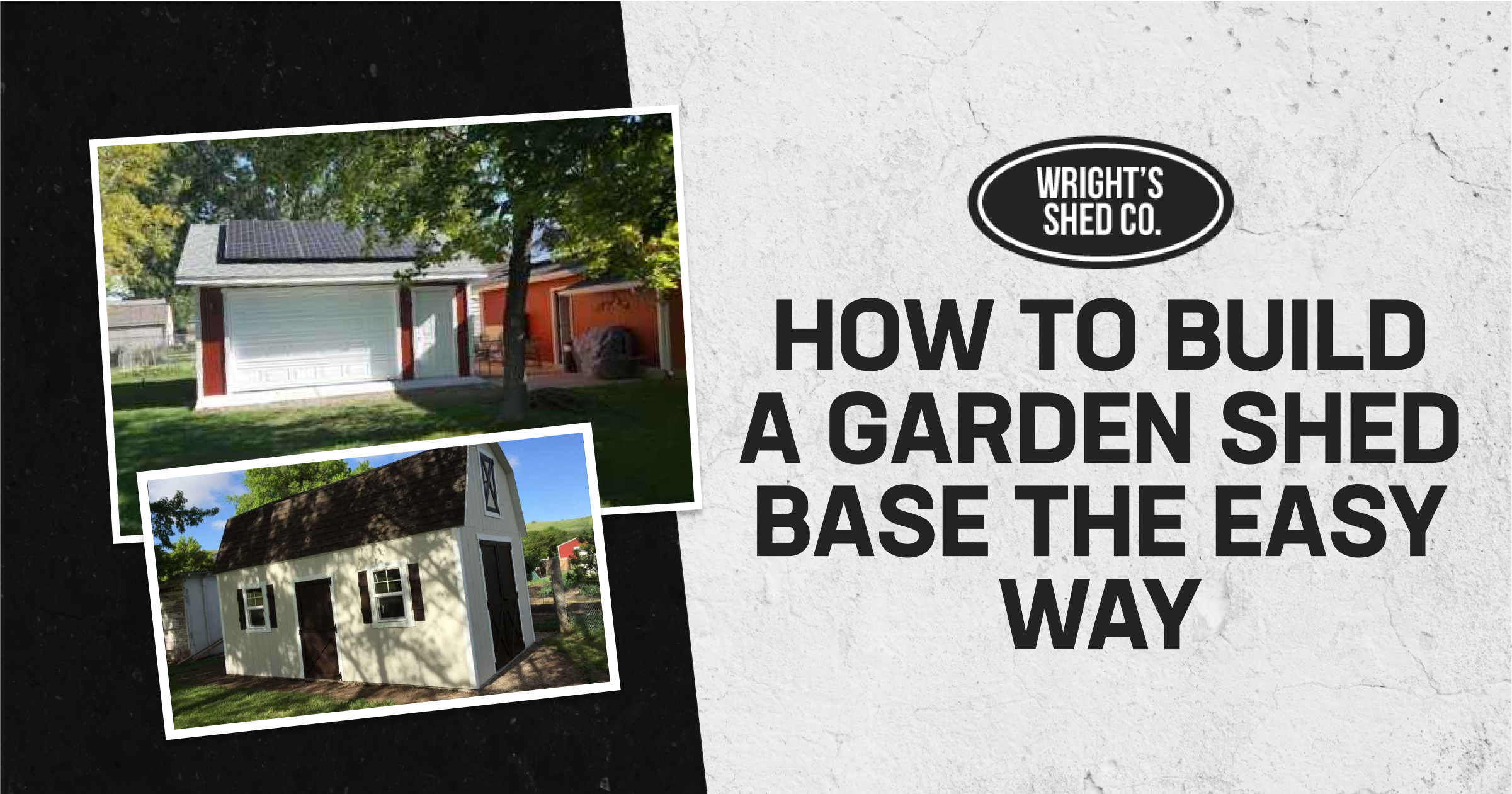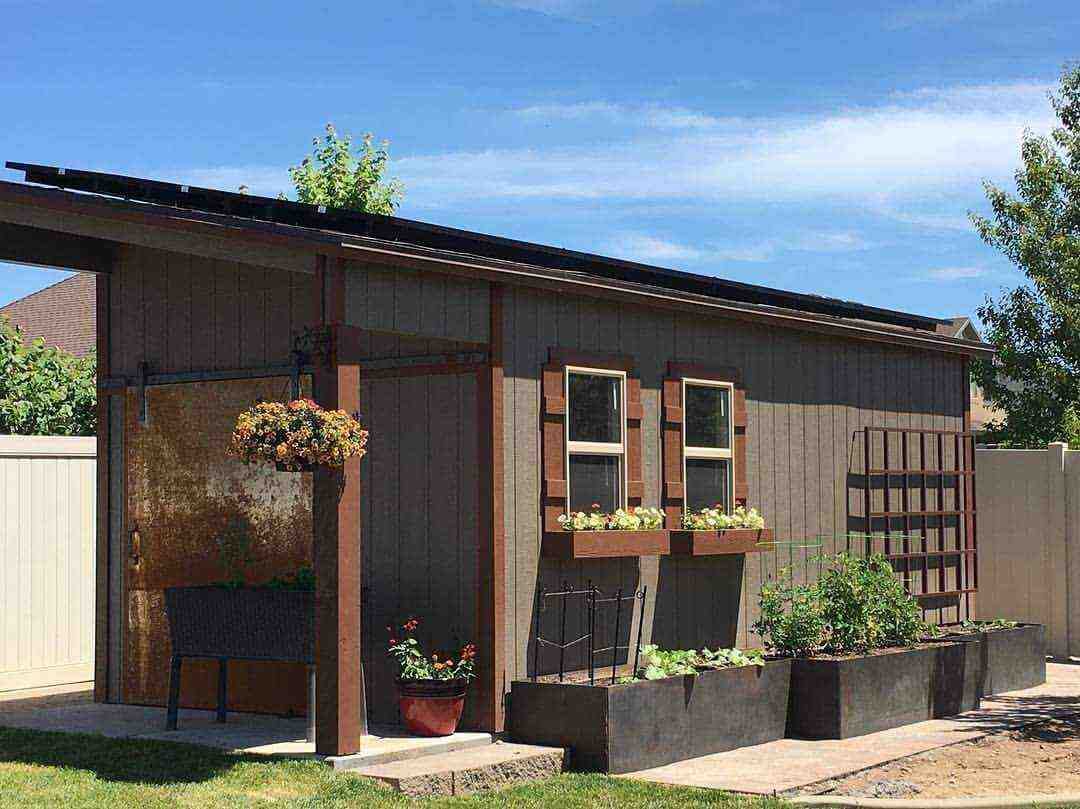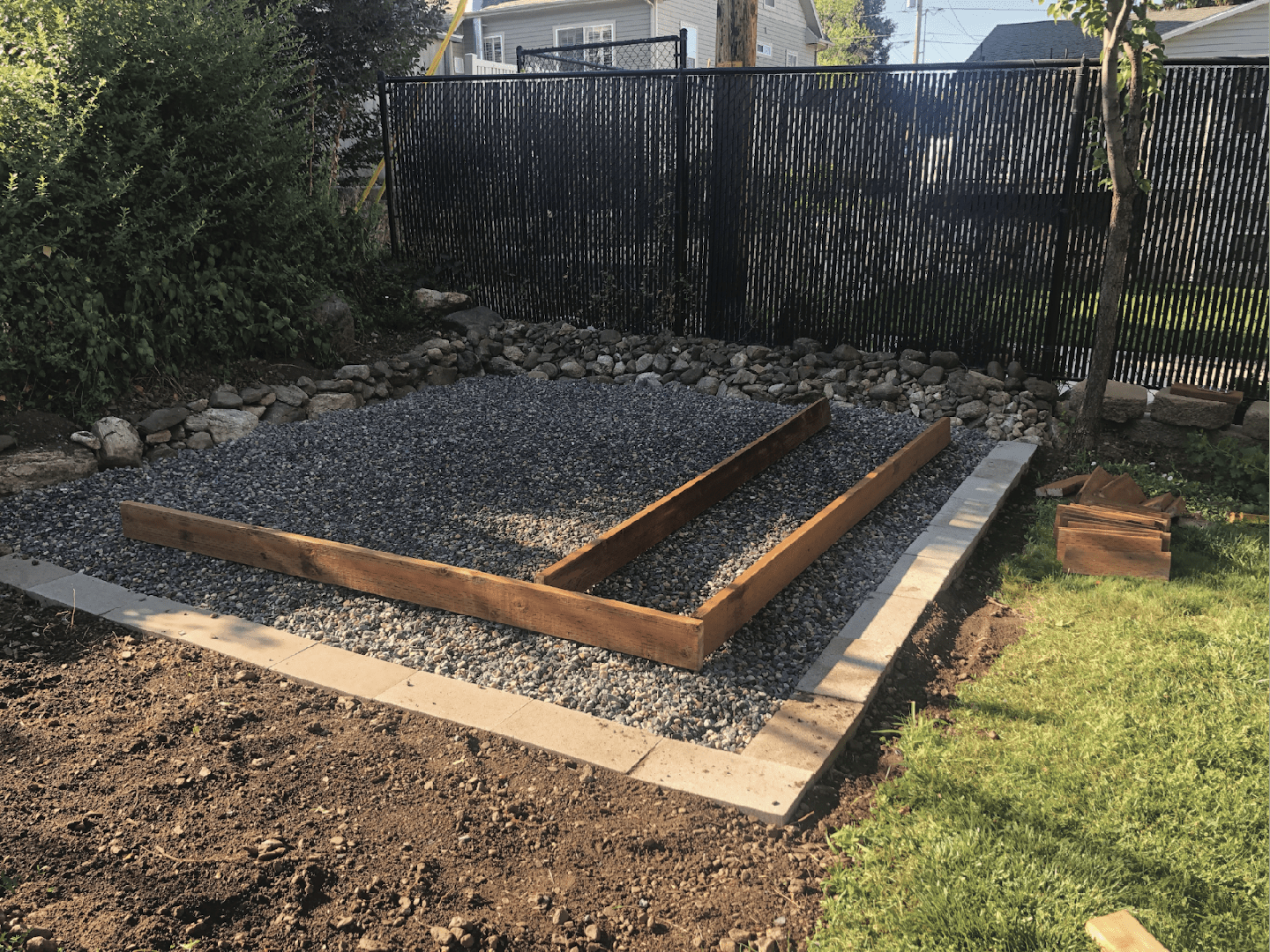Why a Garden Shed Base is Essential for Long-Term Success
A garden shed base is the foundation that determines whether your shed will last decades or fail within a few years. The right base provides structural stability, prevents moisture damage, and ensures your investment stands the test of time.
Quick Guide to Garden Shed Base Options:
- Gravel (Crushed Stone) Pad: Best all-around choice for drainage and durability.
- Concrete Slab: Maximum strength for heavy sheds and workshops.
- Paving Stones: Attractive option for smaller garden sheds.
- Concrete Blocks: Budget-friendly but requires periodic maintenance.
- Timber Frame: DIY-friendly for level ground installations.
Key Requirements for Any Base:
- Level and stable surface.
- Proper drainage away from the structure.
- At least 4 inches elevation off the ground.
- Support for the entire shed footprint.
As one building expert puts it: “The success or failure of your shed relies greatly upon its foundation. Even the best-designed, strongest-built sheds won’t last very long if set upon a weak or poorly constructed base.”
Without a proper garden shed base, you’ll face warped doors, rotting floors, and structural failure. Ground moisture seeps into wooden structures, creating the perfect environment for decay and pest problems.
Preparing Your Site for a Perfect Foundation
Think of preparing your site like setting the stage for a great performance – everything that happens afterward depends on getting this part right. Your garden shed base will only be as good as the groundwork you put in now, so let’s walk through this crucial step together.
Site selection is where it all begins. You want a spot that works with nature, not against it. Look for an area that gets good sunlight – this helps keep moisture levels down inside your shed, which means less chance of mold or mildew. If you’re planning a workshop, consider how you’ll get power to it. For a potting shed, staying close to your garden makes sense.
Here’s something many folks forget: leave yourself room to breathe! You’ll need space around your shed for maintenance, cleaning gutters, or just getting equipment in and out. Trust me, future you will appreciate the extra elbow room.
Before you start digging, check local regulations. I know, I know – paperwork isn’t fun. But getting this sorted upfront saves headaches later. In our service areas of Utah, Idaho, Iowa, and Nebraska, rules can vary quite a bit from one county to the next. Generally, sheds over 200 square feet or taller than 12 feet need permits. Most of our prefab sheds don’t require planning permission, but there are exceptions in conservation areas or if you’re close to property lines. When in doubt, give your local building department a call or check The planning portal.
Drainage assessment might sound fancy, but it’s really just making sure water flows away from your shed, not toward it. Walk around your chosen spot after a good rain – where does the water go? If it pools or sits there, you’ll need to create a gentle slope away from where your shed will sit. Water is your shed’s biggest enemy, so winning this battle early is crucial.
Now comes the physical work: ground leveling and soil compaction. Even if your site looks level to the naked eye, it probably isn’t. This step requires patience, but it’s what separates sheds that last decades from ones that start sagging after a few years.

Preparing the Ground for Your Garden Shed Base
Time to get your hands dirty! This is where your garden shed base really starts to take shape.
Start with area clearance – remove everything. Grass, weeds, rocks, that old garden gnome you forgot about. You want a completely clean slate to work with.
Next comes measurement and marking. Here’s a pro tip: make your base about 6 inches larger than your shed on all sides. So if your shed is 8×10 feet, mark out a 9×11 foot area. This extra space helps with drainage and gives you room to work during installation. Use stakes and string to mark your corners, then measure the diagonals – if they’re equal, you’ve got a perfect rectangle.
Excavation depth depends on your chosen base type, but 4 inches is a good starting point for most projects. This gives you room for your sub-base material and ensures proper drainage.
Here’s where that tamper comes in handy. Using a tamper to compact your soil isn’t the most exciting part of the job, but it’s absolutely critical. Whether you rent a plate compactor or use a hand tamper, this step prevents your shed from settling unevenly over time. If you’ve never used one before, check out this helpful guide on how to use a tamper tool.
Consider laying down weed membrane after compacting. This fabric barrier stops weeds from growing up through your base later – a small investment that saves big headaches down the road.
Throughout this entire process, your spirit level is your best friend. Ensuring levelness isn’t just important – it’s everything. A level base means doors that close properly, windows that don’t stick, and a shed that stays structurally sound for years to come. Check and double-check as you go.
The preparation phase isn’t glamorous, but it’s the foundation of everything that follows. Get this right, and your shed will thank you for decades to come.
The Ultimate Guide to Garden Shed Base Options
With your site properly prepared, you’re ready to choose the perfect garden shed base for your project. After nearly three decades of building sheds, I’ve learned that understanding your foundation options is crucial for making the right choice.
Shed foundations generally fall into two main categories. On-grade foundations (also called floating foundations) sit directly on the ground surface. These work wonderfully for most small to medium-sized sheds and aren’t considered permanent structures, which means you can relocate them if needed.
Frost-proof foundations are the heavy-duty option. These involve digging below your local frost line to prevent frost heave – that annoying upward swelling of soil when it freezes. They’re stronger, more durable, and often required by code for larger sheds or in areas with harsh winters.
Your choice between these depends on several factors: your shed’s size and weight, your local climate, how you’ll use the shed, and your budget. The good news? Most homeowners do perfectly fine with on-grade foundations for typical storage needs.
When comparing materials, durability varies significantly. Concrete slabs can last 50+ years, gravel pads typically serve well for 20-30 years with minimal maintenance, while options like concrete blocks may need attention every 10-15 years.
Gravel (Crushed Stone) Pad
In my experience building thousands of sheds, a gravel (crushed stone) pad with a lumber perimeter is hands-down the best garden shed base for most situations. It’s like the Swiss Army knife of shed foundations – versatile, reliable, and practical.
The excellent drainage is what makes gravel pads shine. Water flows right through instead of pooling around your shed, which prevents the moisture problems that destroy wooden structures. We recommend at least 4-6 inches of stone depth from ground level to ensure proper drainage year-round.
From a cost-effective standpoint, you simply can’t beat gravel. It typically costs about one-third the price of a concrete slab, making it budget-friendly without sacrificing quality. That savings can go toward upgrading your shed features instead.
Most homeowners find gravel pads quite DIY-friendly. While it requires some elbow grease, the process is straightforward. Using pressure-treated 4×4 or 6×6 lumber as a border helps contain the gravel and makes leveling much easier.
Gravel pads are incredibly versatile for slopes too. You can dig out the high side or build up the low side to create a perfectly level surface while keeping your shed door at a comfortable ground level. This flexibility saves you from expensive site grading.
Unlike some foundation types that only support specific points, gravel pads support your entire shed floor evenly. This prevents sagging and distributes weight properly across the whole structure. For more detailed information about installation, visit Gravel shed pads.
Concrete Slab Foundation
When you need maximum durability and aren’t concerned about budget, a concrete slab creates an incredibly robust garden shed base. Think of it as the fortress foundation – built to last generations.
Concrete slabs are ideal for heavy sheds, especially those destined to become workshops with heavy machinery, or storage for tractors and other substantial equipment. The superior moisture protection makes them an excellent long-term investment that can outlast the shed itself.
However, I typically recommend professional installation for concrete slabs. The process involves precise measurements, proper formwork, correct mixing ratios, and expert leveling techniques. While some ambitious DIYers tackle this project, mistakes can be expensive and difficult to fix.
Be prepared for the higher cost – concrete pads can sometimes cost nearly as much as the shed itself. A concrete slab typically runs about three times the cost of a gravel foundation, but you’re paying for decades of worry-free service.
One major advantage is that the concrete slab can serve as your shed floor, providing a seamless, easy-to-clean surface. For frost-proof applications, these slabs often include thickened edges or footers extending below the frost line, sometimes reinforced with wire mesh or rebar to prevent cracking.
Paving Stone Base
For smaller garden sheds where beauty matters as much as function, a paving stone garden shed base offers the perfect blend of practicality and curb appeal.
Aesthetically pleasing paver foundations can beautifully integrate your shed into your garden’s overall design. They create a finished, intentional look that makes your shed feel like a natural part of your landscape rather than an afterthought.
Pavers work best for small to medium sheds with lighter loads. If you’re planning to store heavy equipment or machinery, you’ll want to consider a more robust foundation option.
Most homeowners find paver installation a manageable DIY project. The process is straightforward once you understand the steps, and there’s something satisfying about laying each stone perfectly in place.
The key to success lies in creating a level, compacted sub-base. You’ll need to excavate the area, add a layer of compacted gravel (MOT type 1 hardcore works well), then create a bed of sand or dry cement-sand mix for setting the pavers. Each paver should be level and sit slightly above surrounding ground for proper drainage. For step-by-step guidance, check out Installing a paver foundation.
Paver foundations remain popular because of their simplicity and relative affordability, making them one of the most economical choices available while still delivering attractive results.
Other Viable Options
Beyond the main three foundation types, several other options exist for your garden shed base, each filling specific niches and situations.
Concrete blocks remain popular because they’re inexpensive, easy to install, and particularly useful for leveling sheds on sloped ground. However, always use solid-concrete blocks rather than hollow wall blocks, which can crack and crumble under weight. That concrete blocks don’t support all parts of your shed equally, potentially leading to structural issues over time. For best results, place them on a compacted gravel bed.
Deck blocks are similar to concrete blocks but feature pre-cast concrete piers with slots designed to hold timber beams. This makes them quick to install for small, lightweight sheds while raising the structure off the ground to promote healthy airflow.
Timber frames constructed from pressure-treated lumber (like 4x4s or 4x6s) create simple, effective on-grade foundations. They’re very DIY-friendly and can be set directly on leveled, compacted gravel beds. These frames provide a raised platform and adapt well to slightly uneven terrain.
Plastic grid systems represent a newer, lightweight alternative to traditional concrete foundations. Made from interlocking recycled plastic grids, they offer excellent drainage through their permeable design while providing even support. They cost less than concrete and assemble quickly. Once installed, fill the grids with pea gravel or crushed stone to create a solid, well-drained surface.
Screw piles are the advanced option for challenging situations. These large metal screws get drilled into the ground and extend below the frost line, making them ideal for sloped sites or areas with deep frost penetration. While they require specialized equipment for installation, they provide stable, permanent foundations and simplify shed anchoring in difficult conditions.
Choosing the right foundation means matching your specific shed, site conditions, and budget perfectly. For more comprehensive building advice, including additional foundation tips, visit our Tips on How to Build a Shed.
How to Choose the Right Foundation for Your Shed
Choosing the right garden shed base feels overwhelming at first, but it doesn’t have to be. Think of it like buying a car – you wouldn’t choose a sports car for hauling lumber, right? The same logic applies to shed foundations. Your perfect base depends on your specific needs, and I’m here to help you figure out exactly what those are.
After nearly three decades in the shed business, I’ve seen what happens when people cut corners on foundations. Trust me, spending a little extra upfront saves you thousands in repairs down the road. Let’s walk through how to make the right choice for your situation.
| Base Type | Cost | Durability | DIY-Friendliness | Best Use Case |
|---|---|---|---|---|
| Gravel Pad | (Economical) | High | High | Most sheds, excellent drainage, sloped sites |
| Concrete Slab | (Very High) | Very High | Low (Pro Rec.) | Large, heavy sheds, workshops, permanent structures |
| Paving Stones | (Moderate) | Medium | High | Small to medium sheds, aesthetic appeal, level ground |
Shed size and weight should be your starting point. A small garden tool shed has completely different needs than a workshop filled with heavy machinery. Here’s the reality: if your shed is larger than 200 square feet or you’re storing heavy equipment, you need a robust foundation like a concrete slab. Smaller sheds can get away with gravel pads or paving stones, but always consider the total weight – that includes everything you plan to store inside.
Your intended use matters more than you might think. A simple storage shed for lawn chairs and holiday decorations doesn’t need the same foundation as a woodworking shop with a table saw and drill press. Workshops create vibrations and house heavy tools that demand serious support. For guidance on matching your shed to its purpose, check out our Factors to Consider in Storage Sheds.
Budget considerations can’t be ignored, but here’s where many people make mistakes. Yes, a concrete slab costs about three times more than a gravel pad, and sometimes nearly as much as the shed itself. But think long-term. A proper foundation protects your investment. I’ve seen customers replace entire sheds because they skimped on the base initially.
Choosing the Right Garden Shed Base for Your Project
The difference between on-grade and frost-proof foundations becomes crucial in our service areas of Utah, Idaho, Iowa, and Nebraska. Each state has different frost depths, and ignoring this can spell disaster for your shed.
On-grade foundations sit directly on the ground surface and work great for smaller, lighter sheds in areas without severe frost. They’re simpler and more affordable, making them perfect for many homeowners.
Frost-proof foundations extend below your local frost line – and this matters more than you think. When water in soil freezes, it expands and pushes everything upward. When it thaws, things settle unevenly. This frost heave can crack your foundation and twist your shed’s frame. Check a Local frost depth map to see what you’re dealing with in your area.
Climate impact goes beyond just cold weather. If you live in an area with heavy rainfall, excellent drainage becomes non-negotiable. That’s why we often recommend gravel pads – they handle water beautifully. High wind areas might need stronger anchoring systems, which certain base types accommodate better than others.
Soil type affects everything. Sandy soils drain naturally, while clay soils hold water like a sponge. If you have challenging soil conditions, you might need to invest in a more engineered solution or additional drainage measures.
Your DIY skill level should honestly guide this decision. Laying a gravel pad or installing pavers? Most homeowners can handle that with some effort. Pouring a concrete slab or creating a frost-proof foundation? That’s professional territory. Don’t let pride lead to a costly mistake. While we don’t provide site prep services at Wright’s Shed Co., we’re always happy to connect you with trusted local contractors who specialize in garden shed base preparation.
The bottom line? Match your foundation choice to your shed’s size, your local climate, and your long-term plans. A quality shed deserves a quality foundation – and your future self will thank you for making the right choice now.
Frequently Asked Questions about Garden Shed Bases
After nearly three decades of building sheds, I’ve heard just about every question you can imagine about garden shed base construction. These are the ones that come up most often – and for good reason! Getting your foundation right is absolutely critical to your shed’s success.
Why is a shed base so important?
Think of your garden shed base as the unsung hero of your entire project. Without it, even the most beautifully crafted shed will fail prematurely.
A proper base creates a stable, level platform that prevents your shed from sinking into soft ground or shifting during freeze-thaw cycles. This stability is crucial – when your shed moves even slightly, doors start sticking, windows won’t close properly, and stress cracks appear in the siding.
But the real enemy your base fights is moisture. Ground contact is like kryptonite to wooden structures. A good foundation protects your shed floor from ground moisture that causes rot, mold, and attracts termites and other pests.
Proper elevation is key here. A base should be at least 4 inches high off the ground. This height allows air to circulate freely beneath your shed floor, drying out any moisture and preventing the damp conditions that lead to decay.
I’ve seen sheds built on proper foundations last 30-40 years, while those placed directly on the ground often show serious problems within just 2-3 years.
What is the cheapest way to make a shed base?
When customers ask about the cheapest option, I always remind them that “cheap” can be expensive in the long run if it fails early. That said, I understand budget constraints!
Concrete blocks or a simple timber frame are often the most budget-friendly upfront options for smaller sheds. They’re quick to install and require minimal materials. However, concrete blocks don’t support your entire shed floor evenly, which can lead to sagging over time.
Here’s what I’ve learned works best: a gravel (crushed stone) pad typically offers the sweet spot between affordability and performance. While it costs a bit more than blocks initially, it provides excellent drainage, supports the entire shed footprint evenly, and often outlasts more expensive options.
The math usually works out in your favor too. A gravel base might cost about a third of what a concrete slab costs, but it delivers 80% of the performance for most applications. For detailed cost-saving strategies, check out our Budget Shed Building: Your Cost-Effective Guide.
Can I put a shed directly on the ground?
I get this question a lot, and I understand the temptation – it seems like the easiest route. But I have to give you a firm “no” here, and let me explain why.
Placing a shed directly on bare ground, grass, or an uneven surface is like inviting problems to move in. The floor joists and bottom siding are constantly exposed to moisture from the soil, creating perfect conditions for rot and decay. I’ve seen shed floors completely rot out in just two years when placed directly on the ground.
Without proper air circulation underneath, moisture gets trapped and creates a breeding ground for mold and attracts pests like termites. You’re essentially creating a wooden sandwich with dirt – and that never ends well.
An uneven surface also puts tremendous stress on your shed’s frame. Imagine trying to build a house on a hillside without leveling it first. Doors won’t close, windows jam, and the entire structure twists and warps under the uneven pressure.
Every shed needs some type of garden shed base – even if it’s just a simple gravel pad or concrete blocks. This small investment upfront will save you from major headaches and expensive repairs down the road. Trust me, I’ve been building sheds since 1997, and I’ve never seen a shed placed directly on the ground age gracefully!
Key Takeaways on How to Build a Garden Shed Base
Congratulations! You’ve made it through our complete guide to building the perfect garden shed base. By now, you understand that a solid foundation isn’t just a nice-to-have – it’s the difference between a shed that serves your family for decades and one that becomes a costly headache within a few years.
Think of it this way: you wouldn’t build a house on sand, and your shed deserves the same respect. Whether you choose a gravel pad for excellent drainage, a concrete slab for maximum durability, or paving stones for aesthetic appeal, the key is matching your base to your specific needs.
Remember the essentials we’ve covered: proper site preparation sets you up for success, choosing the right materials ensures longevity, and taking time to level and compact prevents future problems. Even if you’re tackling this as a DIY project, don’t rush these critical steps.
At Wright’s Shed Co., we’ve been building custom storage sheds, garages, and chicken coops since 1997. We’ve seen how a quality garden shed base transforms a good shed into a great one. Our structures are built to last with warranties but even the finest shed needs proper ground preparation to reach its full potential.
A quality shed deserves a quality foundation. When you combine our time-tested building expertise with your carefully prepared base, you’re creating something that will serve your family for generations. That’s the Wright’s way of doing things right the first time.
Ready to start your project? Design your shed and get started on your project, and let’s build something amazing together.




